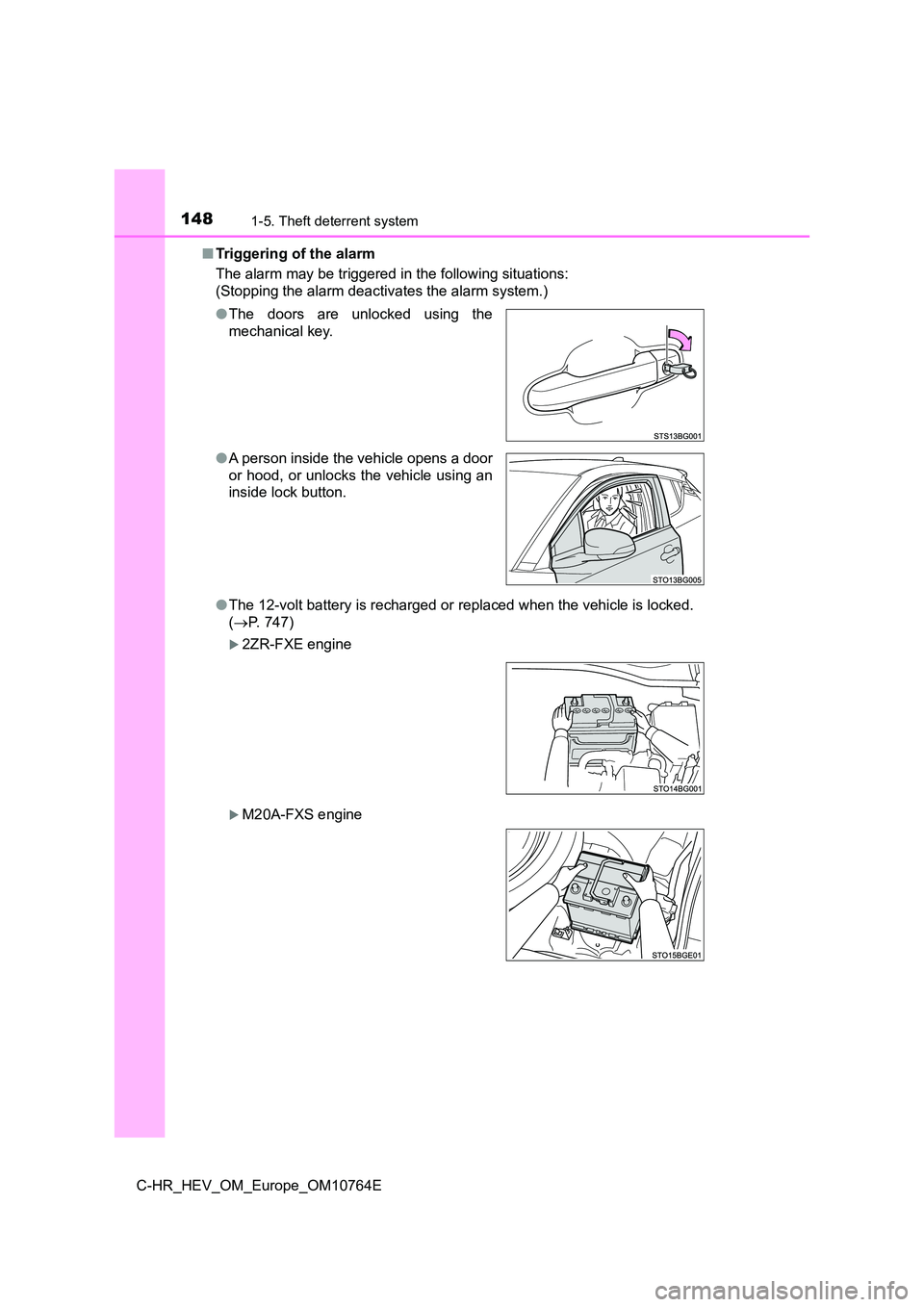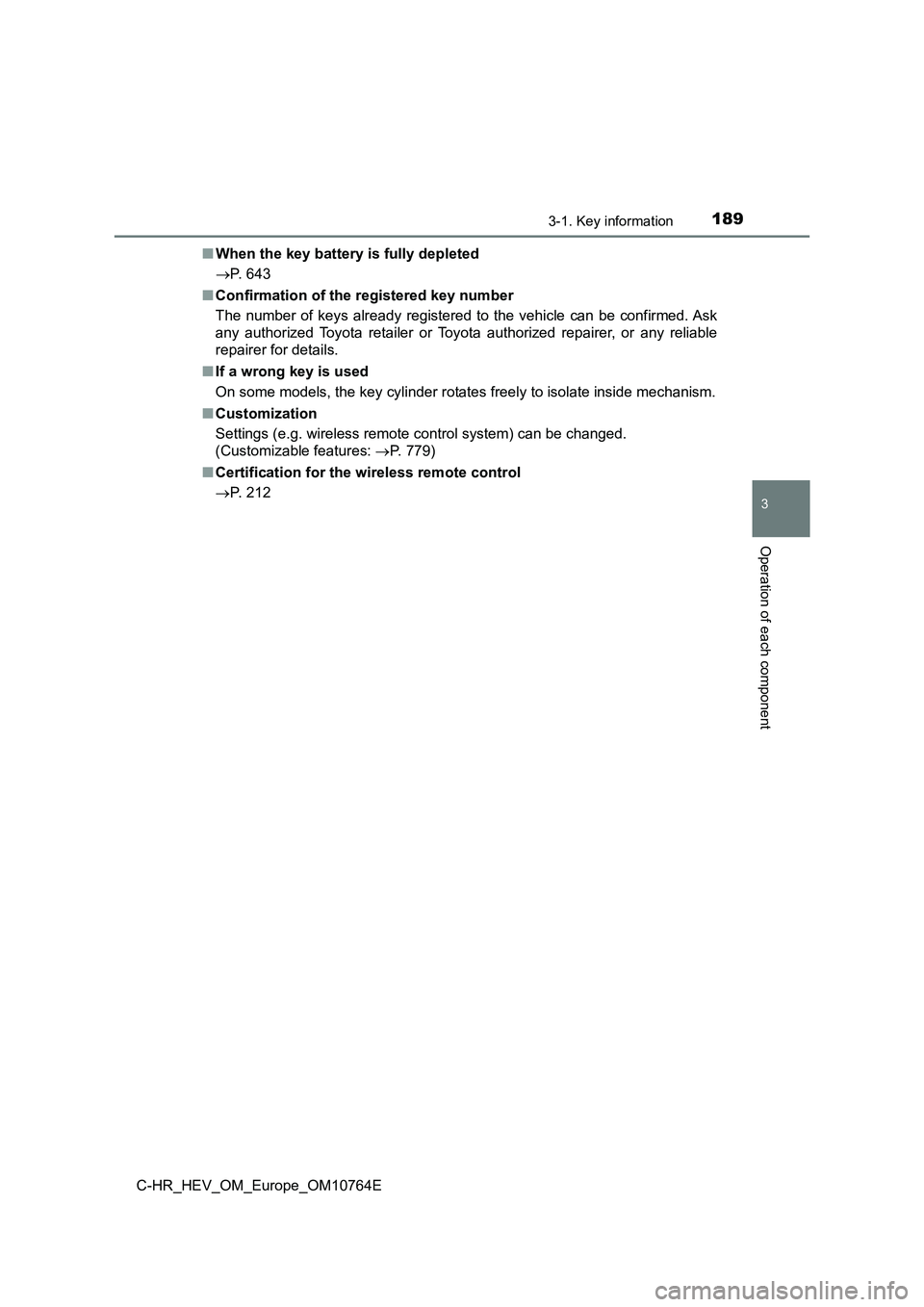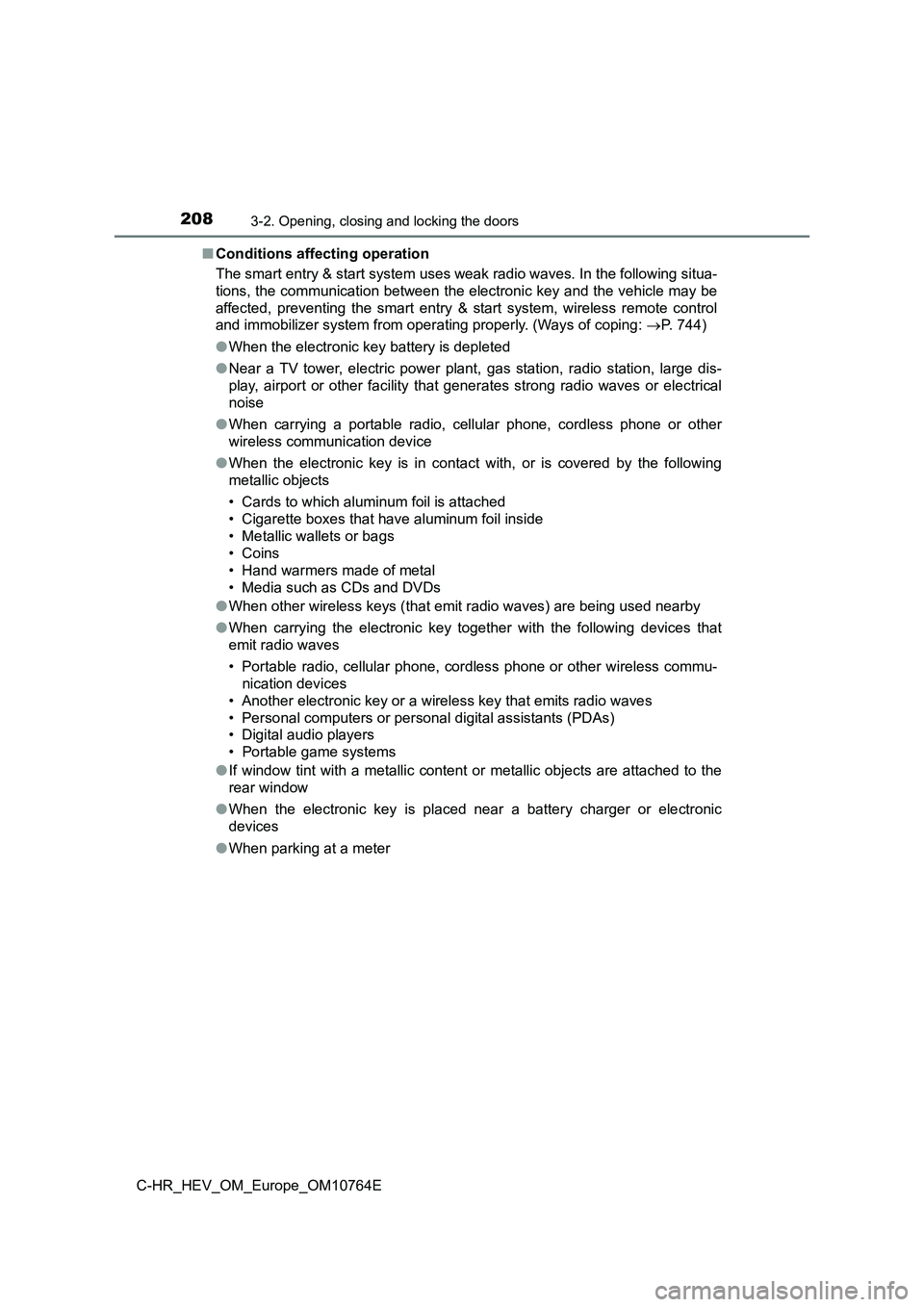2023 TOYOTA C-HR key battery
[x] Cancel search: key batteryPage 7 of 814

5
1
5
4
3
2
C-HR_HEV_OM_Europe_OM10764E
8
7
6
5-1. Using the air conditioning
system and defogger
Air conditioning system ......546
Heated steering wheel/
seat heaters .....................555
5-2. Using the interior lights
Interior lights list .................557
• Interior lights ..................558
• Personal lights ...............558
5-3. Using the storage
features
List of storage features ......560
• Glove box ......................561
• Console box ..................561
• Bottle holders ................562
• Cup holders ...................563
Luggage compartment
features............................564
5-4. Using the other interior
features
Other interior features ........572
• Sun visors ......................572
• Vanity mirrors ................572
• Clock .............................573
• Power outlet ..................574
• Assist grips ....................575
6-1. Maintenance and care
Cleaning and protecting the
vehicle exterior ................ 578
Cleaning and protecting the
vehicle interior ................. 584
6-2. Maintenance
Maintenance
requirements ................... 588
6-3. Do-it-yourself
maintenance
Do-it-yourself service
precautions ..................... 591
Hood.................................. 594
Positioning a floor jack ...... 596
Engine compartment ......... 597
12-volt battery
(M20A-FXS engine) ........ 610
Tires .................................. 614
Tire inflation pressure........ 630
Wheels .............................. 632
Air conditioning filter .......... 635
Hybrid battery
(traction battery)
air intake vent and filter ... 638
Electronic key battery ........ 643
Checking and replacing
fuses ............................... 646
Light bulbs ......................... 651
5Interior features6Maintenance and care
Page 8 of 814

TABLE OF CONTENTS6
C-HR_HEV_OM_Europe_OM10764E
7-1. Essential information
Emergency flashers ...........668
If your vehicle has to be
stopped in
an emergency ..................669
If the vehicle is submerged
or water on the road is
rising ................................670
7-2. Steps to take in an emergency
If your vehicle needs to be
towed .............................. 672
If you think
something is wrong ......... 678
If a warning light turns on or
a warning buzzer
sounds ............................ 679
If a warning message is
displayed ......................... 690
If you have a flat tire
(vehicles with an
emergency tire puncture
repair kit) ........................ 697
If you have a flat tire
(vehicles with a
spare tire) ........................ 727
If the hybrid system will not
start ................................. 742
If the electronic key does
not operate properly ........ 744
If the 12-volt battery is
discharged ...................... 747
If your vehicle overheats ... 755
If the vehicle becomes
stuck................................ 760
7When trouble arises
Page 150 of 814

1481-5. Theft deterrent system
C-HR_HEV_OM_Europe_OM10764E
■ Triggering of the alarm
The alarm may be triggered in the following situations:
(Stopping the alarm deactivates the alarm system.)
● The 12-volt battery is recharged or replaced when the vehicle is locked.
( P. 747)
2ZR-FXE engine
M20A-FXS engine
● The doors are unlocked using the
mechanical key.
● A person inside the vehicle opens a door
or hood, or unlocks the vehicle using an
inside lock button.
Page 190 of 814

1883-1. Key information
C-HR_HEV_OM_Europe_OM10764E
■ Electronic key battery depletion
● The standard battery life is 1 to 2 years.
● If the battery becomes low, an alarm will sound in the cabin and a message
will be displayed on the multi-information display when the hyb rid system
stops.
● As the electronic key always receives radio waves, the battery will become
depleted even if the electronic key is not used. The following symptoms indi-
cate that the electronic key battery may be depleted. Replace t he battery
when necessary. ( P. 643)
• The smart entry & start system or the wireless remote control does not
operate.
• The detection area becomes smaller.
• The LED indicator on the key surface does not turn on.
The battery can be exchanged by the users. ( P. 643) However, as there
may be damage to the key when exchanging, it is recommended to have
the battery exchanged at any authorized Toyota retailer or Toyo ta autho-
rized repairer, or any reliable repairer.
● To avoid serious deterioration, do not leave the electronic key within 1 m
(3 ft.) of the following electr ical appliances that produce a magnetic field:
•TVs
• Personal computers
• Cellular phones, cordless phones and battery chargers
• Recharging cellular phones or cordless phones
• Table lamps
• Induction cookers
Page 191 of 814

1893-1. Key information
3
Operation of each component
C-HR_HEV_OM_Europe_OM10764E
■ When the key battery is fully depleted
P. 643
■ Confirmation of the registered key number
The number of keys already registered to the vehicle can be con firmed. Ask
any authorized Toyota retailer or Toyota authorized repairer, o r any reliable
repairer for details.
■ If a wrong key is used
On some models, the key cylinder rotates freely to isolate insi de mechanism.
■ Customization
Settings (e.g. wireless remote control system) can be changed.
(Customizable features: P. 779)
■ Certification for the wireless remote control
P. 212
Page 195 of 814

1933-2. Opening, closing and locking the doors
3
Operation of each component
C-HR_HEV_OM_Europe_OM10764E
■ Security feature
If a door is not opened within approximately 30 seconds after t he vehicle is
unlocked, the security feature automatically locks the vehicle again.
■ When the door cannot be locked by the lock sensor on the surface of the
front door handle (vehicl es with an entry function)
■ Door lock buzzer
If an attempt to lock the doors using the entry function or wir eless remote
control is made when a door is not fully closed, a buzzer will sound continu-
ously for 5 seconds. Fully close the door to stop the buzzer, a nd lock the
doors again.
■ Setting the alarm (if equipped)
Lock the doors will set the alarm system. ( P. 146)
■ If the smart entry & start system or the wireless remote control does not
operate properly
● Use the mechanical key to lock and unlock the doors. (P. 744)
● Replace the key battery with a new one if it is depleted. (P. 643)
Use your palm to touch the lock sensor.
Page 209 of 814

2073-2. Opening, closing and locking the doors
3
Operation of each component
C-HR_HEV_OM_Europe_OM10764E
■ When “Entry & Start System Malfunction. See Owner’s Manual.” is dis-
played on the multi-information display
The system may be malfunctioning. Have the vehicle inspected by any autho-
rized Toyota retailer or Toyota authorized repairer, or any rel iable repairer
immediately.
■ Battery-saving function
The battery-saving function will be activated in order to preve nt the electronic
key battery and the 12-volt battery from being discharged while the vehicle is
not operated for a long time.
● In the following situations, the smart entry & start system may take some
time to unlock the doors.
• The electronic key has been left within approximately 2 m (6 f t.) of the
outside of the vehicle for 10 minutes or longer.
• The smart entry & start system has not been used for 5 days or longer.
● If the smart entry & start system has not been used for 14 days or longer,
the doors cannot be unlocked at any doors except the driver’s d oor. In this
case, hold the driver’s door handle, or use the wireless remote control or
mechanical key to unlock the doors.
■ Electronic Key Battery-Saving Function
When battery-saving mode is set, battery
depletion is minimized by stopping the
electronic key from receiving radio waves.
Press twice while pressing and
holding . Confirm that the electronic
key indicator flashes 4 times.
While the battery-saving mode is set, the
smart entry & start system cannot be
used. To cancel the function, press any of
the electronic key buttons.
Page 210 of 814

2083-2. Opening, closing and locking the doors
C-HR_HEV_OM_Europe_OM10764E
■ Conditions affecting operation
The smart entry & start system uses weak radio waves. In the fo llowing situa-
tions, the communication between the electronic key and the veh icle may be
affected, preventing the smart entry & start system, wireless r emote control
and immobilizer system from operating properly. (Ways of coping : P. 744)
● When the electronic key battery is depleted
● Near a TV tower, electric power plant, gas station, radio station, large dis-
play, airport or other facility that generates strong radio wav es or electrical
noise
● When carrying a portable radio, cellular phone, cordless phone or other
wireless communication device
● When the electronic key is in contact with, or is covered by the following
metallic objects
• Cards to which aluminum foil is attached
• Cigarette boxes that have aluminum foil inside
• Metallic wallets or bags
• Coins
• Hand warmers made of metal
• Media such as CDs and DVDs
● When other wireless keys (that emit radio waves) are being used nearby
● When carrying the electronic key together with the following devices that
emit radio waves
• Portable radio, cellular phone, cordless phone or other wirele ss commu-
nication devices
• Another electronic key or a wireless key that emits radio wave s
• Personal computers or personal digital assistants (PDAs)
• Digital audio players
• Portable game systems
● If window tint with a metallic content or metallic objects are attached to the
rear window
● When the electronic key is placed near a battery charger or electronic
devices
● When parking at a meter